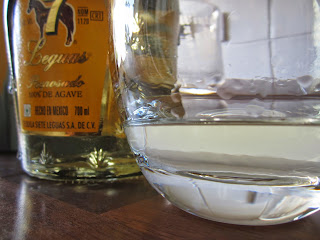I like it when an
impromptu booze conversation breaks out at your local supermarket. The place
was Cheadle’s Sainsburys. A need for something reasonably priced but decent for
my hip flask had led me there when
bring a bottle showed they had the el
Jimador Reposado for 20 quid.
I’d been out of
tequila for a while, and keen to try this one, so I was thinking it would be
good to accompany the Open Golf Championship at the Royal Liverpool. Sadly,
less than 10 minutes after making the purchase I learned I’d be designated
driver for that event so, not only would I not be able to wander around getting
hammered all day, nor would there be a special Open Golf Championship themed
post any time soon. Instead… shall we just talk about the tequila? (reader’s voice – “yeah, suppose so…”).
So, I was in the
checkout line, and I noticed out the corner of my eye that the lady in front
was giving me looks. Now, tequila was the only thing I was buying, I’m in
Cheadle and I’ve pretty much gone out in me trackie bottoms, so I’m thinking I
probably look a bit dodgy. So I decide to pretend I’m not noticing her, but she
actually seems to want to start a
conversation. Which was nice. She actually just wanted to know what I was
buying. What did she say she thought it was… I can’t remember now. Anyway, she
was off home to eat some chocolate and drink some wine.
The
blanco expression was the first 100% agave tequila I ever came to try,
and still sits proudly at the top of my tequila rankings table, so I’d been
keen to try the
reposado for a while.
This one has been aged for between 2 and 3 months (depending on which website
you believe), and at £20 it’s more than £5 less than I paid for the Blanco
originally at Carrington’s.
No, it doesn’t have
the most intriguing bottle or label, but you do at least get a full 70cl (though
only 38 of those ABVs) and frankly, £20 for that much 100% agave tequila is a
bargain. Even before trying this one, I’d recommend you stop buying the standard Jose
Cuervos or the Sierra and get the blanco next time you have tequila
requirements.
I can tell you now,
I do like this tequila. It’s got that slight agave sting, but not quite so much
as its younger, whiter brother, and for that reason I actually prefer the
blanco – yeh, I like the rough nature of the unaged agave.
I had actually been
saving the last drop of my
Jose Cuervo Tradicional [which has previously featured in a post about mediocre alcohol - not because it was bad, but because I didn't have much to say about it] for a direct
comparison with this and, while you might know the result already if you follow
my twitter feed, let’s have a look now, shall we?
Yes.
Vitalstatistix
Let’s remind
ourselves first of all, of the facts:
Cuervo – 100% agave,
50cl, £19.99, 40% ABV
Jimador – 100%
agave, 70cl, £20, 38% ABV
Some calculations.
The Cuervo works out
to nearly 40p per cl while the Jimador is a more generous 28.5p. Remember
though, you’re getting an extra 2 ABVs with the Cuervo. We’ll see how important
those are in the final verdict.
Presentation
As with the blanco
variety, the Jimador has gone for an uninspiring square but clear bottle and a
simple label with an artist’s impression of a tequila farmer. It’s sealed with
a screwcap and an annoying but unintrusive plastic insert – that I don’t
remember being present with the blanco. Another thing I didn’t receive with the
blanco is a little booklet hung around the neck suggesting one or two cocktail
ideas. That’s always a bad sign – not necessarily that the spirit is bad, but
rather that the distributor/manufacturer has chosen to target the mixing
market.
On to the Cuervo
then, which is presented in a narrow bottle with a classic style label that
features a number representative of the number of years since founding that
this bottle was made. A nice touch for those of us who appreciate these kind of
things, but ultimately meaningless. The whole package is delightfully topped
off with a sturdy stopper that makes a marvellous sound when you extract it.
Colour
Once again, not a
massive consideration, but still a grounds for comparison. There’s little to
choose with both brands exhibiting a pale yellow colour but if I had to choose,
I’d say the Cuervo is slightly more in possession of the allure.
Tasting
Having opened both
bottles at the same time for the purpose of photographing, the sweet smell of
agave soon filled the room. It was time to take the glasses into the lounge and
appraise the noses independently. For context, I think we were watching Rocky
iv, which I noticed is more or less just a series of montages – there’s at
least like, four in it. Wi-i-i-i-in, in
the end! I’m gonna win in the end! Wait, that’s Teen Wolf.
Results? I’m
surprised to be saying this, but the Cuervo pretty much sweeps the board –
though not by too much. It just has a slightly greater fragrancy on the nose
leading into more complexity on the palate. Jimador is more subdued, nothing
wrong with it, just if you’re comparing.
The Jimador still
makes a good sipper and can be enjoyed in the various fun tequila ways. Because
it’s good value I don’t mind sloshing it about a bit, so that’s a definite
bonus. So if £20 is your budget, I’d base your purchase on this; if you want a
tequila purely for sipping or impressing guests, get the Cuervo, but if you
want that but you also want to
fritter it away in a series of meaningless trysts, you can’t go wrong with the
Jimador.


.jpg)
.jpg)